Ten years ago, a chatbot was a clunky pop-up that offered a handful of scripted replies. Fast-forward to 2025, and that same interface can now troubleshoot issues, track orders, make appointments, and even show a bit of personality—without involving a single human.
Customer expectations have shifted just as fast. Whether it’s asking about a delayed delivery, refilling a prescription, or managing finances, people want fast, clear, and helpful answers—on their terms, in their language, and without the friction.
That’s where artificial intelligence is making a real difference. Not by replacing people, but by making digital interactions smarter, smoother, and more human.
In this guide, we break down the top Conversational AI trends—what’s working, what’s evolving, and what your business can do today to keep up and stand out.
Table of Contents
The State of Conversational AI in 2025
First, a quick snapshot of where things stand. By 2025, this technology has shifted from experimental to expected—especially for customer-facing teams.
Tech Maturity and Business Readiness
By 2025, Conversational AI is part of how modern companies operate—not just a side project or tech experiment. McKinsey reports that 78% of companies have integrated it into at least one key operational area, and most are seeing steady returns and improved efficiency.
Today, maturity means more than just having the tools. It’s about connecting technology to live data, central knowledge hubs, and multiple channels to guarantee consistency and value at every touchpoint. Leading teams are also combining advanced models with human oversight to improve accuracy and make sure conversations stay helpful, clear, and compliant.
Furthermore, business readiness now includes people. Companies are training teams, adjusting workflows, and setting up infrastructure that allows machine intelligence to grow with their needs. Instead of being an optional upgrade, conversation systems are becoming part of how customer service and operations evolve.
Growing Enterprise Adoption and Customer Experience (CX) Demands
Funding for conversational automation is accelerating to keep pace with higher-than-ever client expectations. In fact, 71% of business and technology professionals reported their organizations had invested in bots for CX support. Furthermore, 80% of firms were either using or planning to adopt AI-powered solutions for customer service improvement by 2025.
CX executives are also increasing their allocations to intelligent communication tools. According to Zendesk, 64% of leaders plan to ramp up investment in Conversational AI chatbots in 2025, and 59% of consumers believe GenAI will change how they interact with businesses within two years. On top of that, companies anticipate it playing a role in 100% of interactions eventually.
What this means for enterprises:
- Prioritize both implementation and user training to unlock chatbot value.
- Scale systems for omnichannel use—from website chat to voice and social apps.
- Balance tech rollout with brand-aligned conversation design and governance.
Leading players are adopting Conversational AI not just to automate but to build trusted, responsive journeys. And the data shows that consumer anticipations are driving that shift.
The Role of AI in Customer Service Today
Currently, delivering an exceptional customer experience still remains a major challenge. Key issues include low CSAT, channel abandonment, and high churn rates. Additionally, these problems often result in inflated operational costs and revenue losses.
Fortunately, Conversational AI for client service stands out as a solution to the pain points. In fact, businesses are already adopting this technology for strategic benefits in lead generation and user engagement. It offers a range of capabilities that boost digital journey quality.
Chat automation systems guarantee personalized interactions and proactive support, which helps lower buyer attrition and improve resolution times. Data-driven insights help to refine client care strategies and better understand market demands. Such improvements bolster consumer allegiance and retention, leading to increased sales and expansion opportunities.

To gain a deeper insight into this market, let’s delve into some key statistics about the CX landscape:
- CX struggles snapshot. 50% of decision-makers admit that their organization faces poor customer experience. Plus, ⅓ mentions difficulties in making their brand more known and influential in the market. Other issues include low CSAT or Net Promoter Score (NPS) rates (44%), abandoned channels (43%), and client churn (39%). These problems also lead to higher operational costs (54%) and revenue loss (51%).
- AI enhancement strategy. To address such challenges, 63% of executives plan to improve or introduce consumer-facing artificial intelligence in the coming year. As a result, the adoption rate of conversational analytics, AI, and automation could increase from 17% to 76%.
- Investments focus. Currently, 52% of organizations have invested in these technologies. The innovations are employed to improve customer service capabilities (62%), elevate client satisfaction (36%), and reduce wait times (33%).
- Benefits from AI adoption. 97% of executives acknowledged that Conversational AI positively influenced user contentment. Additional advantages companies derived from it include boosted agent productivity (94%), faster resolution of consumer issues (92%), and cost reduction (65%).
- Customers’ expectations. Clients eagerly anticipate increased AI interactions (73%), seeing its potential to improve client care quality. Furthermore, 74% believe the technology will significantly boost service efficiency. Recognizing its ability to create personalized communication (74%), consumers expect it to match human-level assistance (75%).
Thus, as clients experience Conversational AI in customer service, excitement for the future grows. Business executives concur, with 41% warning that failing to adopt artificial intelligence risks lagging behind. In this context, identifying the trends reshaping brand-buyer interactions is crucial. For leaders aiming to stay ahead, grasping these directions is key to maintaining the company’s lead in CS innovation. So, let’s explore AI trajectories shaping tomorrow’s consumer engagement landscape.
Why 2025 Is a Pivotal Year for Conversational AI
The year 2025 stands as a defining moment for this technology. That’s not because it marks the start of the journey, but because adoption is hitting critical velocity. After years of trials and fragmented implementations, artificial intelligence in customer experience is becoming a baseline expectation rather than a forward-looking experiment.
Global investment continues to skyrocket. Capital expenditures by major U.S. companies—Apple, Microsoft, Alphabet, Meta, Amazon, and NVIDIA—have climbed to $212 billion, reflecting a 63% year-over-year increase. A significant share of that funding is being funneled into artificial intelligence infrastructure, signaling long-term strategic bets on AI-powered services.
Enterprises are now feeling direct market pressure to deliver smarter, faster assistance. 97% of CMOs say generative tech is already playing a key role in their customer service strategies, a sharp rise from 72% earlier in the year. The urgency is growing, as consumer expectations for speed, personalization, and always-on assistance continue to climb. At the same time, Cisco reports that 55% of IT leaders see AI’s greatest business impact in driving boosting. It’s not just about cost savings, but about fostering more tailored and connected user journeys.
This turning point is also shaped by capability gains. Model training data has grown at an average annual rate of 260%, while compute power for training has surged 360% annually over the past 15 years. These advancements are leading to down-per-interaction costs while enabling smarter, more responsive bots capable of personalized, emotionally-aware communication.
In 2025, Conversational AI isn’t just maturing—it’s being operationalized across industries:
- Retailers use smart assistants to offer real-time inventory updates and suggest products based on past behavior.
- Healthcare providers integrate multimodal bots to manage appointment scheduling, symptom triage, and post-visit follow-ups.
- Financial institutions deploy virtual agents to support everything from onboarding to fraud alerts—24/7.
With rising expectations and intense competitive pressure, companies that hesitate risk falling behind. 2025 isn’t the year artificial intelligence becomes viable—it’s the year it becomes expected.
Business Benefits of Conversational AI in 2025
Conversational artificial intelligence is a strategic lever for measurable impact. In 2025, its value is clearest in the way it elevates every stage of client interaction, from first touchpoint to post-sale loyalty.
- Improved user engagement. Virtual assistants deliver context-rich, dynamic conversations. They retain history, detect tone, and personalize responses, keeping people active, not just present.
- Efficiency and cost savings. By resolving repetitive tasks autonomously, technology reduces agent workload and average handle time. This shift not only improves response speed but also cuts operational costs at scale.
- Competitive differentiation. Companies using Conversational AI systems lead with smarter service. Multilingual support, instant onboarding, and emotion-aware replies turn artificial intelligence into a brand advantage, not just a backend tool.
- Better customer satisfaction. Smart automation means less waiting, fewer transfers, and more relevant answers. The result is higher CSAT scores and greater loyalty, especially among digital-native users.
For businesses aiming to scale without sacrificing quality, these advantages are no longer optional. Conversational AI for enterprises is shaping the new CX baseline—faster, smarter, and more human than ever.
7 Critical Conversational AI Trends: Guide Your Business to Lead, Not Follow
Conversational AI is swiftly reshaping the realm of customer interaction. By 2030, its market value is expected to soar to $32 billion, marking a 19% yearly growth since 2021 (Market Splash). Such an expansion is fueled by the increased use of chatbots in businesses, with their adoption projected to nearly double in the next 2-5 years.
Bots are not just proliferating; they’re driving significant economic benefits. Predictions for 2025 suggest digital assistants could reduce client service costs by as much as $11 billion (ZipDo). This technology is especially pivotal in the financial and tech sectors, where enhancing CX is a top priority for 77% of professionals.
The impact of Conversational AI is particularly notable in contact centers. Gartner estimates that by 2026, its integration in these customer interaction hubs could cut agent labor costs by a staggering $80 billion. Furthermore, the post-pandemic era has seen artificial intelligence become essential, with a 250% increase in handled interactions, highlighting its crucial role in modern business (HootSuite).
While the numbers sound promising, let’s delve into the actual trends steering the future of Conversational AI. Our focus will be on how these directions define the CX domain, ushering in an age of advanced efficiency and user engagement.
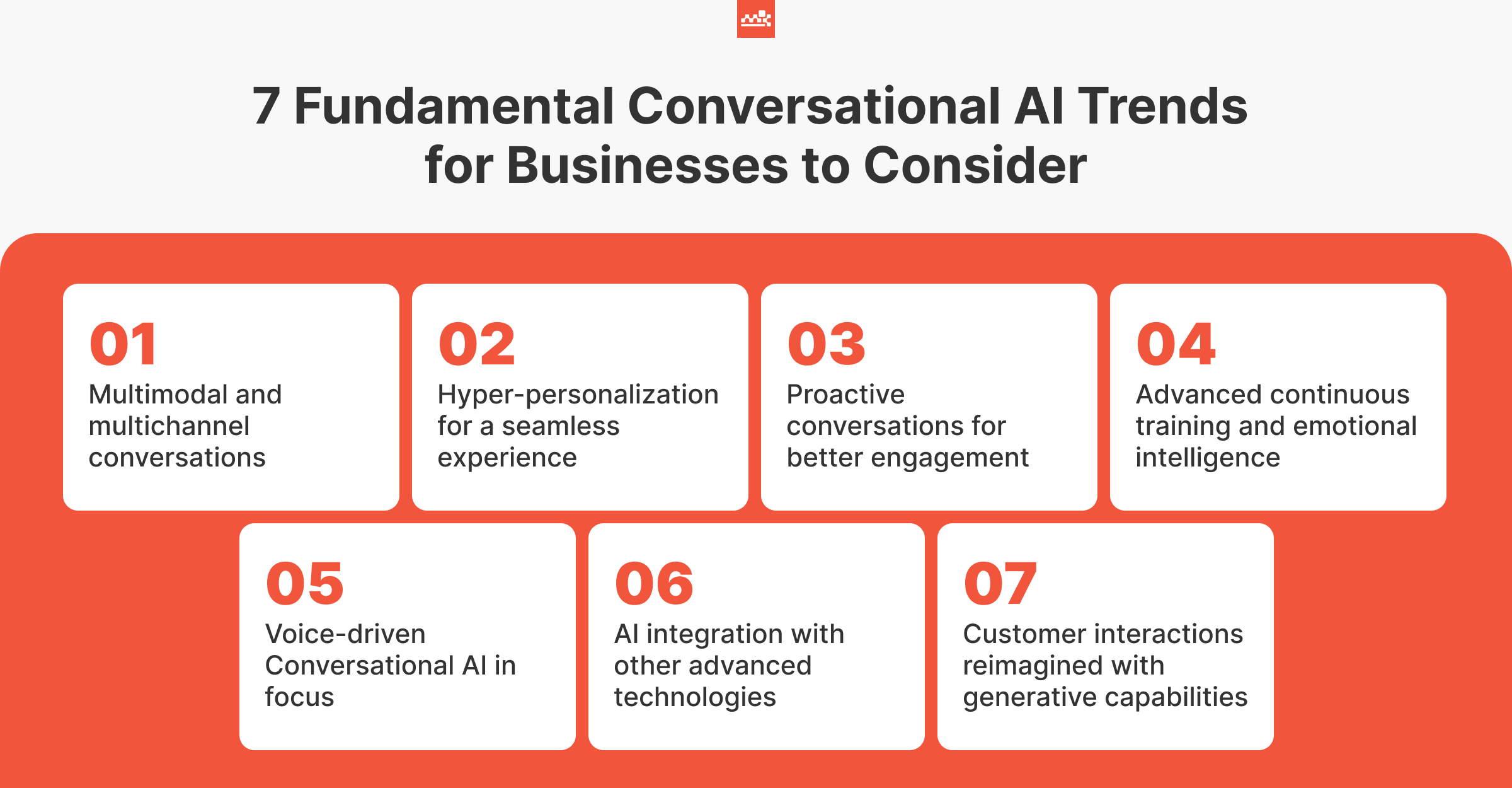
Proactive Conversations for Better Engagement
Conversational AI is now shifting from simply reacting to initiating proactive interactions. This leap is powered by intelligent analytics and advanced intent recognition. Utilizing real-time client data, these tools provide insights into preferences, sentiments, and behaviors. The observations empower marketers to refine conversational experiences more effectively.
In the realm of personalized customer conversations, proactive recommendations are becoming increasingly important. Approximately 65% of consumers favor receiving offers and suggestions that cater to their specific needs. Personal touch is a key factor in differentiating CX and enhancing user engagement strategies.
In conversational commerce, anticipatory consumer assistance is taking a front seat too. A significant 71% of customers show a preference for brands that deliver proactive support. Businesses are leveraging buyer data to anticipate and address their demands proactively. By analyzing behavior and patterns, chatbots are positioned to offer help or suggestions even before the customer requests it.
This approach to client care is boosting the CX to a completely new level. Not only does it save time, but it also conveys a sense of thoughtfulness and value to the consumers. In fact, 72% of users experiencing proactive support report higher satisfaction levels. Beyond reacting to inquiries, Conversational AI is now adept at interpreting information to forecast needs, thereby reducing buyer frustration and enhancing their loyalty.
Multimodal and Multichannel Conversations
Multimodal interfaces are revolutionizing how we interact, combining text, voice, images, and videos for richer dialogues. Such systems allow users to communicate more naturally, using voice commands, gestures, and emojis. This enhances experiences across various channels, making interactions more immersive.
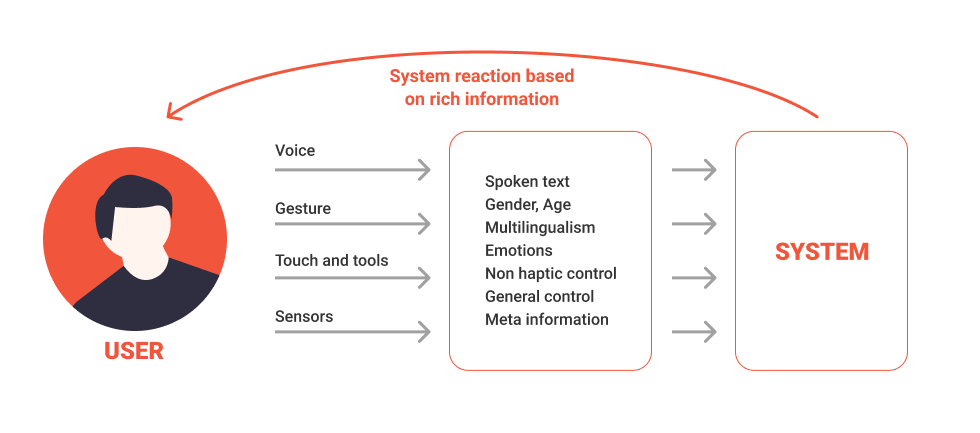
In fact, consumer preferences for brand touchpoints were diverse in 2022. Emails led with 64%, followed by website or app chats at 47%. Social media exchanges stood at 36%, and text messages at 28%. These trends indicate a clear shift towards mixed communication modes.
Nowadays, half of consumers prefer multimodal interactions as their go-to communication format. The choice is reshaping how brands approach customer engagement. IDC forecasts that by 2026, 40% of AI models will blend different data modalities. Such an integration will surpass the constraints of single-modality artificial intelligence, improving their effectiveness and self-learning capabilities.
The addition of components like image recognition and document processing is already streamlining work. For instance, tasks requiring extensive typing are now simplified through photo uploads. This not only saves time but also adds to the convenience. Looking forward, Conversational AI’s future seems to hinge on its ability to seamlessly incorporate multimodality across various channels.
Advanced Continuous Training and Emotional Intelligence
Artificial intelligence tomorrow is anchored in combining next-level model optimization with emotional competence. In fact, 7 out of 10 consumers now expect the technology to understand and react to their emotions. This anticipation is guiding the development of more empathetic chatbots. Today’s cutting-edge digital assistants use NLP and machine learning (ML) for effective self-improvement. And 72% of users have noticed AI’s growing ability to comprehend human language and communication styles.
In general, digital assistants are evolving by analyzing user input, identifying patterns, and deriving lessons from each interaction. The method enables them to respond more accurately and contextually. The results are further enhanced with the assistance of augmented intelligence, merging technology with human feedback. It allows experts to work alongside AI, enhancing the learning process and fostering ongoing improvement.
The emergence of Large Language Models (LLMs) introduces even more sophisticated modifications. LLMs for enterprises synthesize data to strengthen NLP and help align consumer statements with their intended meanings. It also boosts emotional intellect in chatbots. As a result, AI offers caring support and addresses client concerns more effectively. Interestingly, 64% of users already recognize artificial intelligence’s improved response to their emotions.
Another critical aspect influencing the trend is conversation design. It allows businesses to create empathetic, inclusive, and accessible CX. Additionally, ethical solution configuration is gaining importance, ensuring responsible and sensitive interactions. These advancements raise user satisfaction and trust, forging new paths for impactful technology use in various industries.
Hyper-Personalization for a Seamless Experience

The evolution of Conversational AI has been remarkable, transitioning from simple chatbots to advanced, personalized systems. Thanks to natural language processing (NLP), digital assistants now grasp user intents and tailor responses. This makes conversations more relevant and engaging.
Customers’ expectations are evolving too, with 70% anticipating companies to leverage AI for customized interactions and offers. Thus, the trend toward personalization is becoming more pronounced. About 61% of consumers prefer dealing with brands that offer quick, tailored user journeys. Additionally, 66% of buyers expect businesses to recognize their unique needs and preferences.
Hyper-personalization in Conversational AI is responding to these expectations effectively. It enriches brand engagements, fosters customer loyalty, and enhances business outcomes. Moreover, clients are increasingly open to sharing personal information with such systems, as noted by a Zendesk report. The survey reveals that two-thirds of buyers are willing to exchange more data for deeper individualization if artificial intelligence powers their interactions.
The trajectory of hyper-personalization in Conversational AI is set to redefine various applications. It promises to continuously evolve, crafting seamless and more delightful buyer journeys, resulting in higher revenues.
Voice-Driven Conversational AI in Focus
Voice assistants (VA) are reshaping interactions between users and technology. Today, 82% of companies have integrated the technology into their operations. This encompasses applications like automatic speech recognition (ASR), transcription, machine translation, etc. Such innovations offer more dynamic and accessible ways for buyers to engage with businesses. Naturally, nearly 2/3 of consumers express a desire for more voice-based exchanges with AI and chatbots.

The reach of VA extends across various sectors, including healthcare, banking, and retail. It simplifies routine tasks, such as scheduling appointments and managing prescriptions, enhancing CX. Other business benefits of these solutions are clearly reflected in recent surveys. 74% percent of respondents highlight improved speech-to-text accuracy, while 68% acknowledge enhanced conversation intelligence capabilities. Additionally, 64% recognize the cost-saving advantages of voice AI.
With the continuous advancement of technology, the value of Conversational AI for customer engagement is growing. An overwhelming 85% of decision-makers foresee its widespread adoption within the next five years. The future of VAs is bright, promising further enhancements in ASR, NLU, and speech synthesis. These advancements continue to revolutionize customer interactions, making them more intuitive and enjoyable.
Integration with Other Advanced Technologies
The combination of Conversational AI with different innovative instruments like VR, MR, and AR is reinventing the digital customer journey. The fusion offers users immersive and personalized experiences. For instance, VR and AR allow for virtual product showcases and interactive support. This is a new way to demonstrate items and raise sales.
AI algorithms, when combined with such tools, deliver real-time insights, product details, and guided assistance. The integration not only enriches the user experience but also increases their engagement. A significant 71% of consumers report boosted shopping frequency with AR. As these applications advance, they promise to transform client service, supporting a unique, memorable brand image.
Conversational AI’s fusion with the Internet of Things (IoT) further expands its potential. Intelligent IoT devices can offer more customized and proactive consumer care. Imagine smart gadgets that predict buyer needs, offering shoppers help during their visit even before it’s requested. This combination heralds a new era of efficient, personalized customer service. Collectively, the advancements in artificial intelligence and associated technologies are setting higher standards for interactive and tailored CX.
Interactions Reimagined with Generative Capabilities
Conversational AI brings strengths like context understanding, user intent recognition, and sophisticated NLP. Its dialogue management and knowledge integration are crucial for nuanced conversations. Gen AI, on the other hand, excels in creating engaging content, fostering natural chats, and offering creative problem-solving. Together, they provide personalized CX overcoming LLM limitations.
This fusion significantly enhances handling complex interactions. It enables a deeper grasp of context and conversation subtleties. Such capabilities are vital for supporting more diverse use cases across several industries at once. The combined technology can manage intricate dialogues with improved precision and relevance.
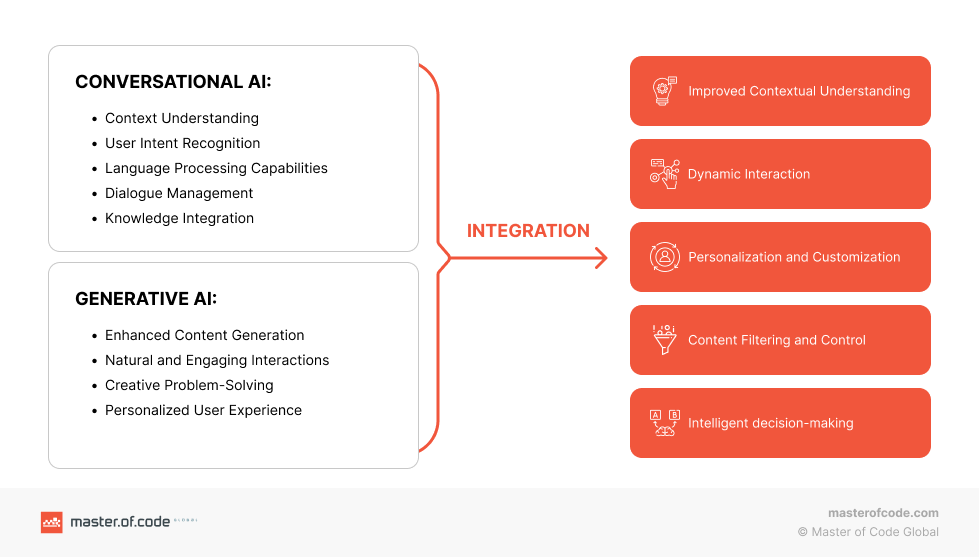
Moreover, the integration facilitates intelligent decision-making and dynamic interaction customization. It filters and controls content to align with client needs and preferences for more meaningful engagement. The synergy between Conversational and Generative AI is not just about processing information. It’s about creating connections and understanding that resonate with customers on an in-depth level.
In application, this means the tools can now navigate scenarios of greater complexity. They get better at interpreting and responding to varied inquiries. The solutions can route responses smartly, either handling them within the AI system or directing them to the appropriate human agent. Such versatility makes it an invaluable asset for businesses aiming to cover a wide range of interactions with enhanced efficiency and empathy.
Emerging Trends Reshaping Conversational Technologies
By 2025, this tech has evolved well beyond simple chatbots. The transformation toward smart, industry-aware solutions is becoming a defining strategy.
Autonomous Agents & Agentic AI
Organizations are piloting autonomous AI agents in workflows like claims processing, customer onboarding, and order management. Deloitte finds that 25% of companies using GenAI will run agentic pilots in 2025, growing to 50% by 2027. These systems make decisions across tools, schedule actions, and learn from outcomes, reducing manual handoffs and enabling self-driving service.
Governance, Ethics & Compliance
Enterprises are formalizing AI ethics governance as regulations tighten and applications gain complexity. IAPP reports that over 50% of organizations involve privacy, legal, IT, and security teams in AI oversight—marking a shift from siloed compliance to multi-disciplinary governance. Yet only 14% enforce full enterprise-level assurance, pointing to clear opportunity in scaling controls.
AI-Powered Search Interfaces
Natural language processing-savvy implementations are replacing static search forms. Salesforce data reveals 69% of service agents actively use NLP tools to auto-turn requests into structured answers. Users increasingly expect natural queries, such as “find my last invoice,” and search engines are adapting. This trend enables smoother self-service in industries like banking and retail.
Industry-Specific Solutions
Vertical focus is accelerating. Retailers deploying Conversational AI chatbot experiences report a 30% drop in support costs, as precise product guidance replaces generic responses. Similar value appears in finance, telecom, and healthcare, where bots are trained on sector-specific terms, compliance standards, and decision-flows.
No-code and Low-code AI Development
To scale quickly, teams are embracing no-code and low-code AI platforms. The market is expected to grow from $5.55 billion in 2024 to $7.09 billion in 2025—a 27.7% CAGR. Moreover, 84% of enterprises now use these tools to close IT gaps and speed up deployment cycles. This democratization empowers non-technical roles to build and refine assistants directly.
Evolving Conversations: The Journey of Conversational AI
From FAQs, to transactional experiences
Conversational interface projects often start with a proof of concept involving launching a virtual assistant that can automate responses to frequently asked questions (FAQs) via chat or voice.
Organizations that want to increase customer satisfaction and achieve business goals need to start looking beyond just FAQs to reap the actual benefits of conversational AI.
Today’s advanced Conversational AI systems that utilize NLU can automate many complex transactions to make life easier for client and internal teams. For example, banks could enable bill payments via virtual assistants instead of just navigating customers to a ‘how to pay’ webpage. A food retailer could allow buyers to order food using a virtual agent rather than just navigating to a ‘menu’ page on their website.

Building a transactional virtual assistant does not necessarily mean total call center automation with all possible transactions. Organizations need to take a structured approach and use data to prioritize key transactions that are high-volume and high-impact. This will help them deliver more value to their customers and move them closer to meeting their business objectives.
From linear, to flexible and cyclic conversations
Organizations need to be mindful that they are creating experiences for real people who are on the other end of the virtual assistants. Therefore, it is paramount to keep clients in mind during the entire process. This shift is profound and places the onus on organizations to deliver a seamless user experience to lessen the user’s cognitive burden.
To continue providing a fluid customer experience, organizations need to anticipate and map out every possible scenario, query, and response. They need to design flexible conversations so that person can converse using their own words in addition to picking from pre-defined menus. They should also be able to change the direction of dialogue or request additional information along the conversation’s path. Lastly, the Conversation Design needs to be cyclical so customers can pivot and circle back to the conversation as per their preference without starting over. Human to human conversations themselves are not linear and neither should conversational interfaces.
From release and forget, to iterating and tuning
Many organizations that build virtual assistants invest in upfront research and design to understand the customer journey and context. They sometimes, however, drop the ball on iterating and fine-tuning the experience after releasing the virtual assistants to actual customers.
It is crucial for organizations to monitor and evaluate actual conversations to really understand what is working and what isn’t. Reviewing user sessions to investigate errors and determine how to improve the experience should be an integral part of an ongoing sustainment plan.
Continuous iteration or ‘bot tuning’ is another critical practice for maintaining a balance of necessary intents and their training data. Tuning could involve various activities like adding, removing, or modifying utterances. Removing intents that don’t add value is just as important as creating new ones.
This results in customer journeys that are as seamless and as simple to navigate as possible. It also increases engagement and containment within the conversational experience.
From pre-defined answers, to Natural Language Understanding and Conversation Design
At its core, conversation design aims to mimic human conversations to make digital systems like virtual assistants easy and intuitive to use. The challenge is to make interactions with these systems feel less robotic by understanding the context and purpose of the customer in order to direct them to relevant solutions.
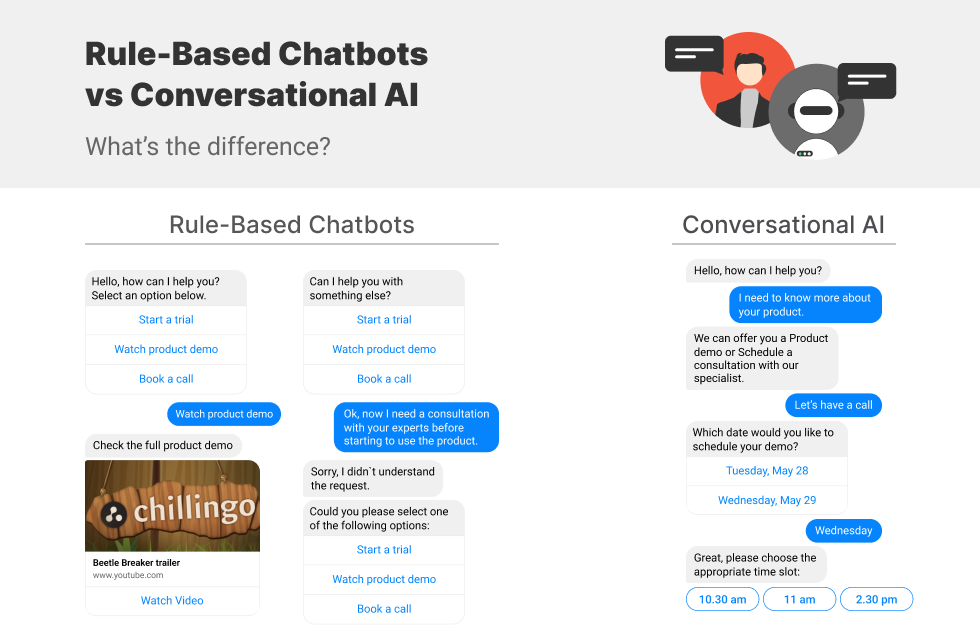
Many organizations, however, still employ hard-coded or rule-based pattern matching with small rule-sets for their conversational interfaces. This results in higher abandonment rates, low engagement, and perceived project failures.
Natural Language Understanding (NLU) technologies utilize machine learning and training data that allows them to understand user utterances without the need to manually hard code all the pattern matching logic. NLU platforms also provide hooks into domain-specific knowledge bases and forums.
By integrating and maximizing the power of NLU platforms, organizations can enable virtual assistants to respond to human queries efficiently and effectively, improving engagement and providing an overall positive customer service experience.
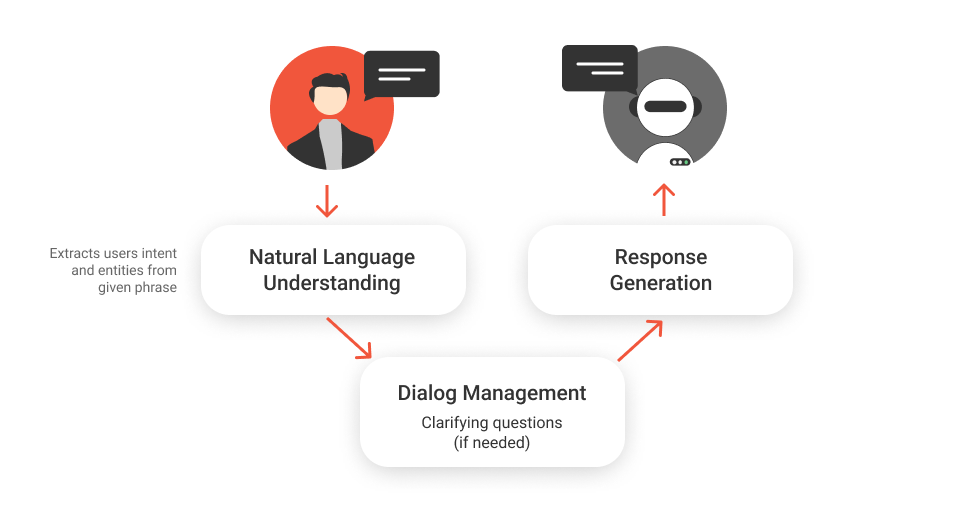
From disjointed multiple bots, to a seamlessly integrated omnichannel experience
With an increase in the development of virtual agents, some larger organizations are facing a new challenge. Individual departments are creating conversational interfaces with a narrow scope of handling queries related to very specific use-cases or business functions such as HR or IT. As a result, accessing and discoverability of the numerous virtual assistants becomes a challenge for users.
When appropriate for their situation, organizations can overcome this challenge with the introduction of a “master virtual assistant”. This assistant can be made responsible for handling a range of tasks for the customer by understanding their intent and routing the request to the use-case-specific virtual agent. For example, a financial institution may have separate chatbots to handle commercial and consumer mortgage use cases and a master chatbot that seamlessly manages the interactions across them.
Challenges in Conversational AI Adoption
Even as artificial intelligence becomes more common, the path to full-scale deployment is anything but smooth. Here are the biggest blockers we see across industries.
- Data privacy & compliance. 40% of organizations have experienced an AI-related privacy breach, and over 50% of consumers view its use of personal data as a significant threat to privacy. With growing regulation and public scrutiny, businesses must implement robust data governance and transparent usage policies before deployment.
- Managing bias. Roughly 63% of clients worry about bias and discrimination in algorithm decision-making, prompting calls for transparent intent-handling and fairness checks. Yet only a fraction of companies currently audit or adjust their training data to counteract bias.
- Integration with legacy systems. 22% of IT decision-makers report they have data trapped in systems that cannot be migrated, and 79% struggle with undocumented pipelines. This creates barriers for real-time integration, pushing teams to invest heavily in data modernization or middleware.
- User trust & adoption barriers. Confidence struggles create immense pressure: 57% of global consumers view AI as a privacy threat, and 61% remain distrustful of such systems. Without clear value and transparency, clients hesitate to embrace automated service, even when it’s available.
Each of these issues highlights the distance between machine intelligence’s potential and its practical rollout. Addressing them is critical to building solutions people actually want to use. Let me know if you’d like to integrate visuals or real-world remediation strategies for any challenge.
Artificial Intelligence Trends in 2025 by Industry
Driven by advances in Conversational AI, leading players are moving beyond automation to build trusted, responsive experiences.
Retail & eCommerce
- Shift toward conversational shopping & AI-driven product discovery to replace traditional search bars.
- Rise of voice-based and multimodal commerce integrated with smart devices.
- Growing focus on intelligent personalization in loyalty and retention strategies.
- Adoption of proactive notifications (e.g., restocks, delivery updates).
- Expansion of retail-specific governance to ensure brand-aligned conversations.
Also worth exploring: the rise of Conversational AI for consumer goods and how it’s redefining shopping journeys at scale.
Healthcare & Wellness
- Virtual health assistants are becoming standard for non-urgent care navigation.
- Increasing use of emotionally aware algorithms for mental wellness and behavior change.
- Integration of healthcare Conversational AI into remote patient monitoring and chronic care plans.
- Movement toward HIPAA-compliant tooling for higher data sensitivity.
- Providers using machine intelligence for patient education and follow-up engagement at scale.
Finance & Banking
- Push for AI-enabled financial coaching for mass-market banking users.
- Rise of regulatory-compliant conversational apps in high-stakes interactions.
- Banks investing in hyper-personalized digital concierge bots.
- Chatbots transitioning from reactive to predictive financial support tools.
- Emphasis on trust-building AI tone and transparency in customer communication.
HR and Internal Operations
- Shift to secure, audit-ready tools for enterprise-grade HR compliance.
- Uptick in employee-facing copilots to assist with daily workflow tasks.
- Trend toward smart onboarding with conversational walkthroughs.
- HR teams embedding automation for pulse surveys and morale tracking.
- Increased demand for AI-native knowledge bases accessible via chat.
Conversational AI Statistics in 2025: Insights from 8 Strategic Angles
The numbers speak for themselves:
- The global Conv AI market is projected to grow from $12.24B in 2024 to $61.69B by 2032, while the chatbot one will rise from $7.01B to $20.81B by 2029. Meanwhile, artificial intelligence platforms alone will scale from $234.8M to $589.8M in the same period.
- North America leads innovation, filing over 60% of all Conversational AI patents globally.
- On the enterprise side, 71% of business and tech professionals say their companies have invested in bots, and 64% of CX leaders plan to increase bot budgets in 2025.
- In retail and eCommerce, which account for 21% of the global market, anticipated chatbot spending will hit $72B by 2028. Also, 66% of U.S. consumers show strong interest in using Generative AI-driven conversational commerce, and 44% rely on digital assistants for product research.
- In finance and banking, the BFSI sector captures 23% of the chatbot market, with 48% of U.S. banks planning to integrate GenAI into customer-facing bots. Additionally, 33.2% of U.S. adults were expected to use banking bots by the end of 2024.
- In healthcare, chat assistants’ adoption is projected to grow at a 33.7% CAGR through 2028, with 81% of consumers having used bots or voice agents for support. Of those, 37% used them specifically for symptom-checking. On top of that, cloud-based intelligent medical solutions are set to grow at a 63.4% CAGR.
- From the client’s perspective, 67% approve of artificial intelligence handling support tasks, and 91% of CX executives believe this technology enables highly personalized experiences.
- 90% of CX “trendsetter” brands report positive ROI from copilots in their customer service teams, highlighting major efficiency gains.
Implementing Conversational AI: Your Next Move
Getting started with conversational applications? Success depends on how well you plan, build, and scale, not just which tool you pick. Here are simple tips to getting it right the first time.
- 1. Choose the Right Vendor
Pick a partner who does more than just deliver code. Look for:- Experience with enterprise-grade conversational solutions.
- Industry-specific knowledge (e.g., healthcare, banking).
- Support for integrations, multilingual bots, and analytics.
- Security and compliance expertise (GDPR, HIPAA, SOC2).
- 2. Start With Strategy
Before building anything, align your goals and identify how Conversational AI maps to real business outcomes. A good implementation plan answers:- Can we do it? (Tech feasibility)
- Should we do it? (Business value)
- How will we measure success? (Impact & KPIs)
- 3. Prep Your Data Early
Algorithms can’t learn without good data. Before launch, audit what you have:- Is your data structured, labeled, and relevant?
- Are systems integrated or siloed?
- Do you have the right permissions and governance?
- 4. Define Clear KPIs
Performance isn’t just about precision, it’s about outcomes. Monitor metrics such as:- Containment rate (how many queries the bot resolves solo)
- Escalation rate
- CSAT & NPS post-chat
- Average handle time
- Cost-per-interaction vs. human agents
- 5. Train, Tune, Repeat
Model performance improves over time if you feed it the right feedback. Invest in:- Curated training datasets from real customer queries
- Ongoing intent mapping and NLP tuning
- A/B testing to improve flows
- Feedback loops with human agents and QA teams
- 6. Build a Cross-Functional Team
You don’t need to hire everyone in-house. But someone needs to:- Manage the project (PM)
- Define use cases and flows (BA, CD)
- Build and tune the model (ML/AI engineers)
- Maintain governance (compliance and security leads)
- Measure and optimize results (data analysts)
Advanced Conversational AI isn’t just a tech deployment—it’s a transformation. Start with a strategy. Align your data, tools, and people. Measure what matters. And choose a partner who understands the difference between launching a bot and launching a solution.
Want help mapping it out? Start here.
The Future of Conversational AI: 2025 to 2030
This technology is entering a new era, one where it no longer just responds, but actively supports, decides, and collaborates.
- From reactive to proactive: Virtual assistants will shift from scripted responders to autonomous agents capable of initiating actions based on user behavior, context, or real-time data. These systems won’t wait for a prompt. They’ll suggest, remind, and even solve before users ask.
- Rise of hybrid AI-human teams: In workplaces, expect seamless collaboration between employees and copilots. These assistants will handle repetitive tasks, prep data insights, and flag anomalies, freeing humans to focus on creativity, strategy, and emotional intelligence.
- Artificial intelligence as decision support, not just automation: Organizations will increasingly use AI solutions to amplify complex decision-making. From financial forecasting to care coordination in healthcare, technology will surface trends, compare options, and simulate outcomes, making leaders faster and more confident in their choices.
- Emotionally aware AI: Advances in sentiment analysis, voice modulation, and behavioral cues will enable it to better read and adapt to human emotions. This won’t be limited to customer guidance—it will affect learning, healthcare, and personal assistants, helping build trust and reduce friction in digital interactions.
- Convergence with other modalities: Multimodal Conversational AI is becoming standard. Eventually, chatbots will “see” (via camera input or image recognition), “hear” (via voice and sound cues), and “speak” across multiple channels. This will allow unifying conversations across voice, text, and visuals.
- Customized Conversational AI at scale: With improved model fine-tuning and transfer learning, enterprises will be able to deploy purpose-built bots trained on proprietary data. They will be delivering brand-specific tone, domain fluency, and contextual accuracy without requiring huge custom builds.
- Governance will define competitiveness: As machine intelligence becomes embedded in everyday operations, how well companies govern, monitor, and ethically use these tools will become a competitive differentiator. Transparent, explainable tech will be the baseline, not the exception.
By 2030, Conversational AI for enterprises won’t be an interface. It’ll be infrastructure: a core layer of how people interact with businesses, services, and each other. Those who plan today will lead tomorrow.
Key Takeaways
As we have explored, Conversational AI is redefining client care and retention. The technology not only addresses the current challenges in CX but also opens up new avenues for enhanced consumer interaction and business growth. From providing personalized offers to boosting service quality, artificial intelligence is an indispensable tool for any forward-thinking enterprise.
At Master of Code Global, our leadership in Conversational AI services positions us to help your company stay ahead of the curve. With our guidance, adopting discussed trends becomes a seamless process, leading to improved business outcomes. We provide an omnichannel approach, ensuring consistent CX across all platforms.
Partner with us for a full-cycle artificial intelligence strategy and robust integration capabilities. We prioritize flexible communication and stringent data security in all our applications. Contact Master of Code Global to elevate your user engagement with advanced AI solutions. Let’s redefine your customer interactions together.
Ready to build your own Conversational AI solution? Let’s chat!







